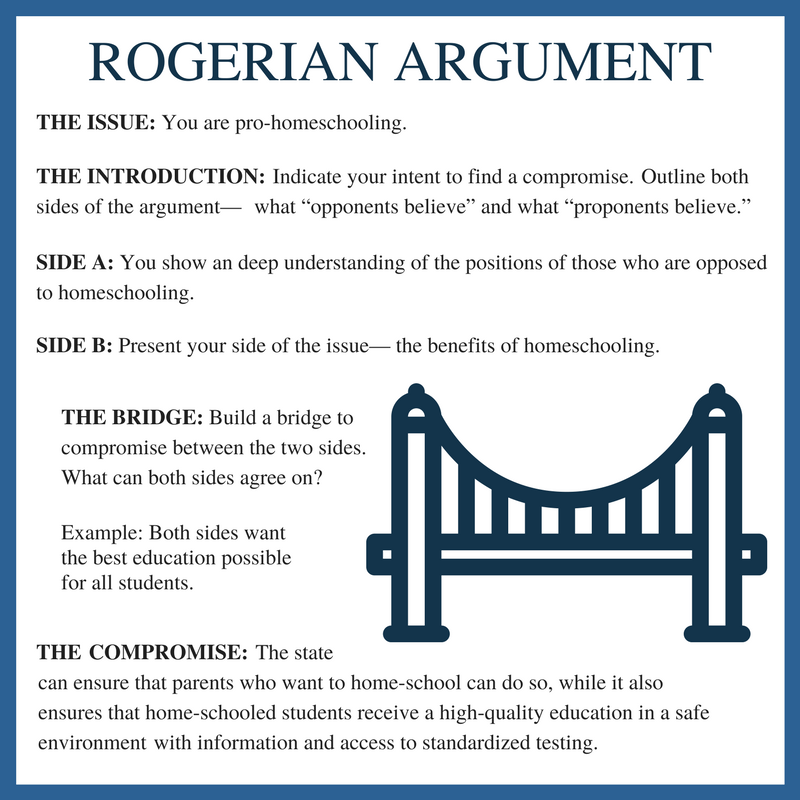19 The Rogerian Argument
Kirsten DeVries
The Rogerian argument, inspired by the influential psychologist Carl Rogers, aims to find compromise or common ground about an issue. If, as stated in the beginning of the chapter, academic or rhetorical argument is not merely a two-sided debate that seeks a winner and a loser, the Rogerian argument model provides a structured way to move beyond the win-lose mindset. Indeed, the Rogerian model can be employed to deal effectively with controversial arguments that have been reduced to two opposing points of view by forcing the writer to confront opposing ideas and then work towards a common understanding with those who might disagree.
Figure 3.9 “Carl Ransom Rogers”

The following are the basic parts of a Rogerian Argument:
1. Introduction: Introduce the issue under scrutiny in a non-confrontational way. Be sure to outline the main sides in the debate. Though there are always more than two sides to a debate, Rogerian arguments put two in stark opposition to one another. Crucially, be sure to indicate the overall purpose of the essay: to come to a compromise about the issue at hand. If this intent is not stated up front, the reader may be confused or even suspect manipulation on the part of the writer, i.e., that the writer is massaging the audience just to win a fight. Be advised that the Rogerian essay uses an inductive reasoning structure, so do not include your thesis in your introduction. You will build toward the thesis and then include it in your conclusion. Once again, state the intent to compromise, but do not yet state what the compromise is.
2. Side A: Carefully map out the main claim and reasoning for the opposing side of the argument first. The writer’s view should never really come first because that would defeat the purpose of what Rogers called empathetic listening, which guides the overall approach to this type of argument. By allowing the opposing argument to come first, you communicate to the reader that you are willing to respectfully consider another’s view on the issue. Furthermore, you invite the reader to then give you the same respect and consideration when presenting your own view. Finally, presenting the opposition first can help those readers who would side against you to ease into the essay, keeping them invested in the project. If you present your own ideas first, you risk polarizing those readers from the start, which would then make them less amenable to considering a compromise by the end of the essay. You can listen to Carl Rogers himself discuss the importance of empathy on YouTube (https://youtu.be/2dLsgpHw5x0, transcript here).
3. Side B: Carefully go over your side of the argument. When mapping out this side’s claim and support, be sure that it parallels that of Side A. In other words, make sure not to raise entirely new categories of support, or there can be no way to come to a compromise. Make sure to maintain a non-confrontational tone; for example, avoid appearing arrogant, sarcastic, or smug.
4. The Bridge: A solid Rogerian argument acknowledges the desires of each side and tries to accommodate both. In this part, point out the ways in which you agree or can find common ground between the two sides. There should be at least one point of agreement. This can be an acknowledgement of the one part of the opposition’s agreement that you also support or an admittance to a shared set of values even if the two sides come to different ideas when employing those values. This phase of the essay is crucial for two reasons: finding common ground (1) shows the audience the two views are not necessarily at complete odds, that they share more than they seem, and (2) sets up the compromise to come, making it easier to digest for all parties. Thus, this section builds a bridge from the two initial isolated and opposite views to a compromise that both sides can reasonably support.
5. The Compromise: Now is the time to finally announce your compromise, which is your thesis. The compromise is what the essay has been building towards all along, so explain it carefully and demonstrate the logic of it. For example, if debating about whether to use racial profiling, a compromise might be based on both sides’ desire for a safer society. That shared value can then lead to a new claim, one that disarms the original dispute or set of disputes. For the racial profiling example, perhaps a better solution would focus on more objective measures than race that would then promote safety in a less problematic way.
Figure 3.10 “Rogerian Argument”

Sample Writing Assignment 5
Find a controversial topic, and begin building a Rogerian argument. Write up your responses to the following:
- The topic or dilemma I will write about is…
- My opposing audience is…
- My audience’s view on the topic is…
- My view on the topic is…
- Our common ground–shared values or something that we both already agree on about the topic–is…
- My compromise (the main claim or potential thesis) is…

